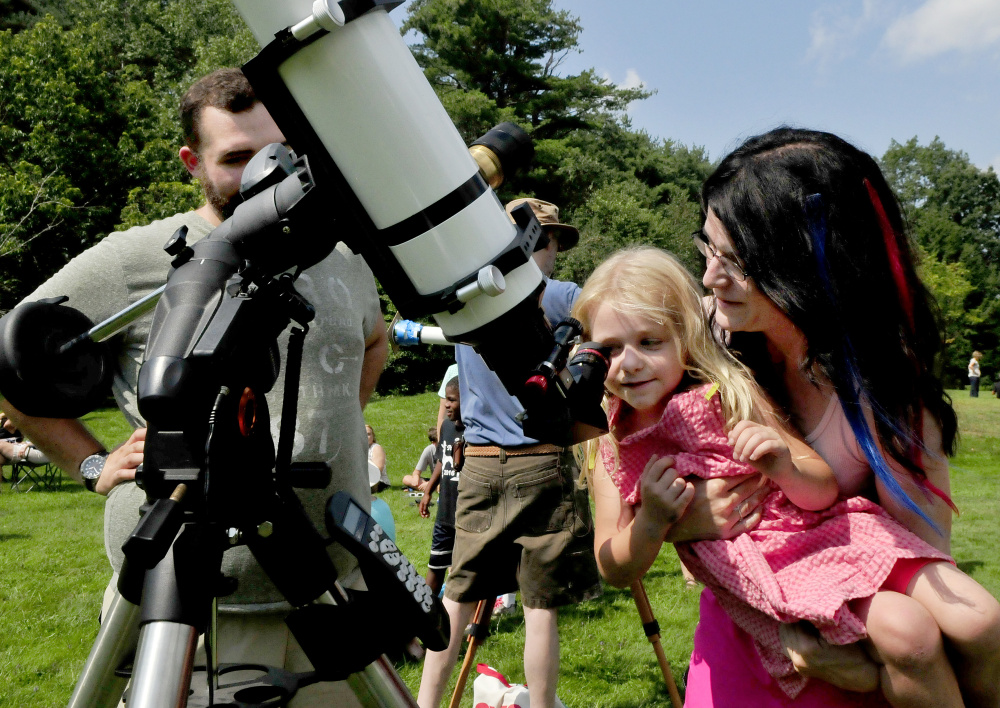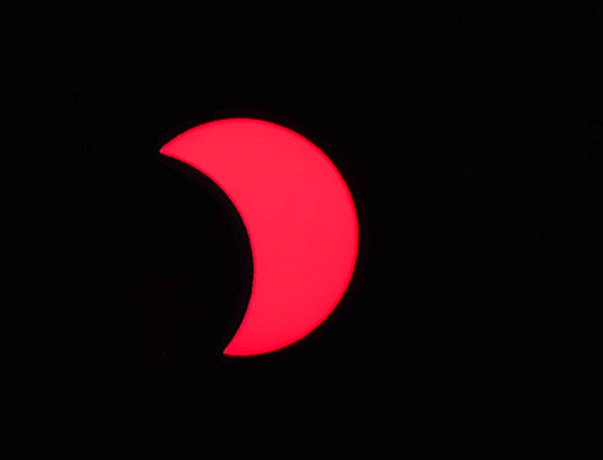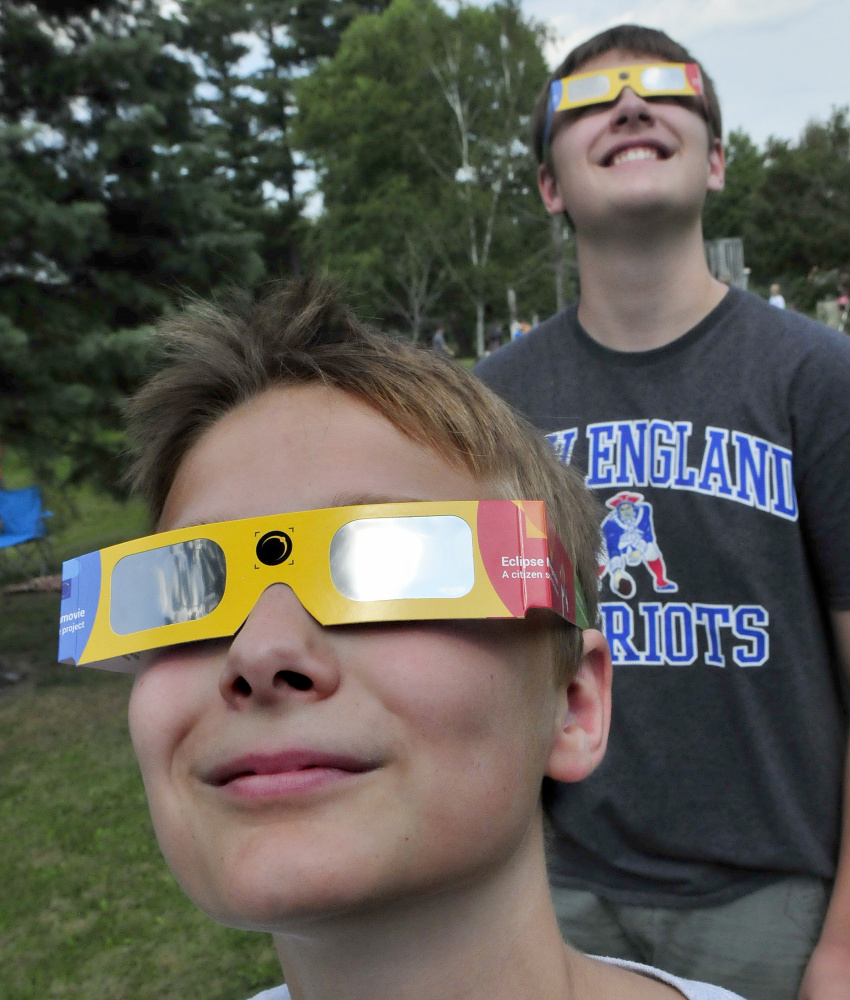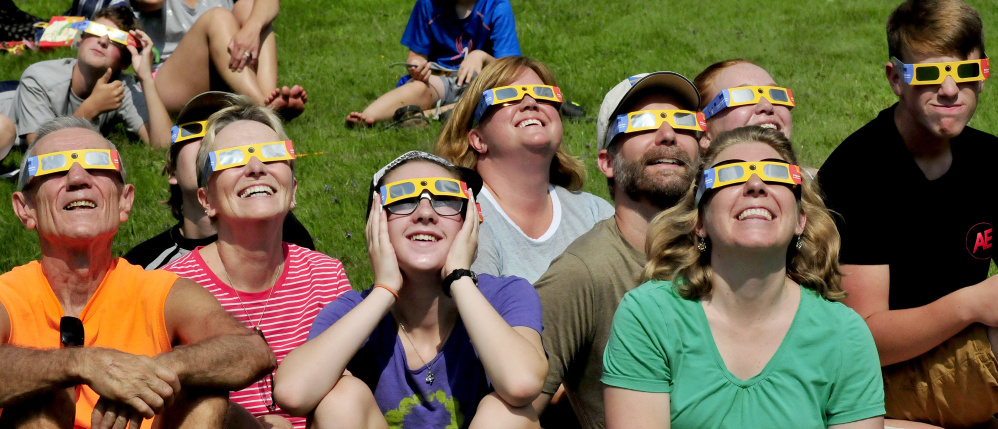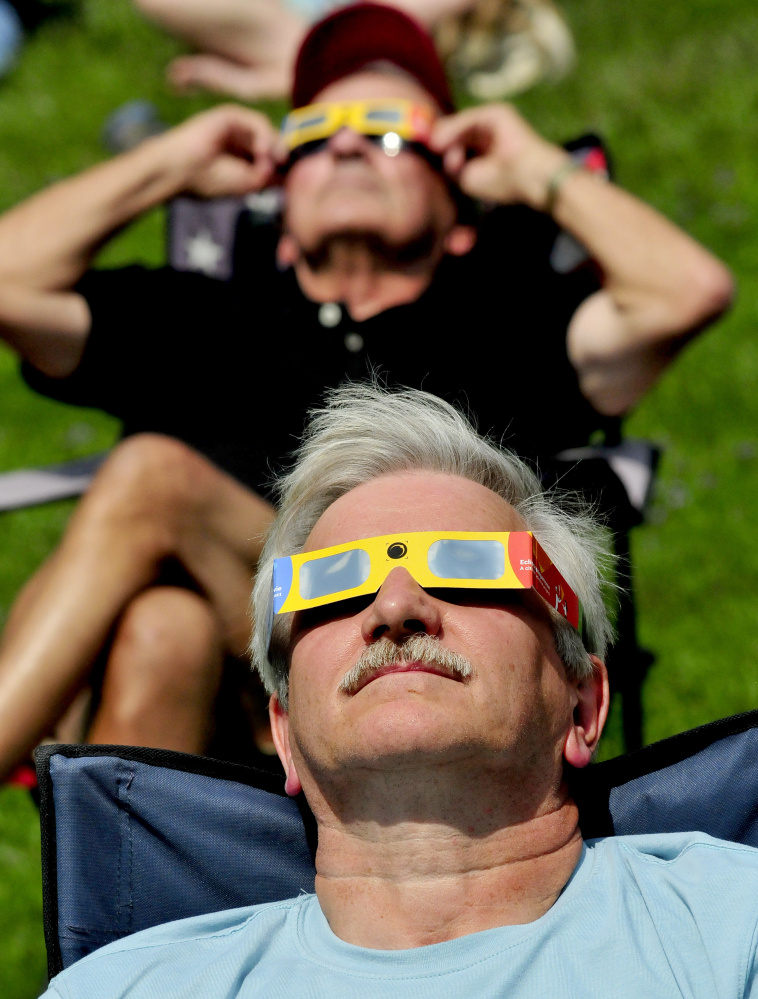FAIRFIELD — Millions of Americans gazed in wonder through telescopes, cameras and disposable protective glasses Monday as the moon blotted out the sun in the first full-blown solar eclipse to sweep the U.S. from coast to coast in nearly a century.
Many Americans staked out prime viewing spots and settled onto blankets and lawn chairs to watch the most-observed and most-photographed eclipse in history, especially along the path of totality — the line of deep shadow created when the sun is completely obscured except for the ring of light known as the corona.
Some 200 million people live within a day’s drive of the path of totality, a corridor just 60 to 70 miles wide where the darkness stretched from Oregon and traveled diagonally across the Midwest to South Carolina, but lasted only two to three minutes in any one spot, while the rest of North America was treated to a partial eclipse, including the L.C. Bates Museum where organizers were surprised by the crowd that turned out to watch the celestial display.
“We’ve handed out 300 pairs of glasses today,” said Deborah Staber, director of the museum located on the Good Will-Hinckley campus in Fairfield. Add to that the 3,000 pairs the museum handed out in the days approaching Monday and the audience that watched the moon cast its shadow on the red disk of the sun grows. The museum gathered about 4,000 sets of glasses from a number of places, Staber said, some of which were free.
About a hundred people sat out on the lawn behind the museum to experience the first total eclipse since 1991, even though Maine was nowhere near the path of totality this time around. The eclipse in the Pine Tree State was much smaller than it was in western and southern states, approximately 60 percent compared with some areas that experienced 100 percent totality and darkness. But in 2024, the United States will again see a total solar eclipse — and this time northern Maine will be right in the path of totality.
Kimberly Simpson, of Oakland, brought her 11-month-old daughter, Sophia, to the Bates Museum partly because she knew the organizers had the solar eclipse viewing glasses that protect a person’s eyesight while looking up at the sun.
“I figured it would be a cool thing, to say when you were a baby you saw your first eclipse,” said Simpson said, who was seeing her first eclipse as well.
For some, Monday wasn’t their first go-around.
“Oh, I’ve seen one or two,” Linda Gillis said. Three generations of her family had come to L.C. Bates to watch the event, which was the first for her three grandchildren.

The moon slips in front of the sun showing the corona of the sun during a complete eclipse in the middle of the path of totality in Sweetwater, Tenn., on Monday. The corona is the outer edge only visible within the 70-mile range of the path of totality. Sweetwater was in a unique spot to witness the entirety of the path of totality for more than two minutes.
“I’m really excited,” Brennan Gillis, 13, said. He and his brother, Connor, 15, his sister Macy, 10, and his father Kyle were visiting from Massachusetts and decided to go to the museum event to get the appropriate glasses so they could look up at the eclipse.
More than one parent was amazed to see teenagers actually look up from their cellphones.
In Laramie, Wyoming, Matt Nagy said that the eclipse made him “whoop and holler” and that even his two teenage daughters were impressed: “It takes a lot to get a teenager excited about something.”
Jon Silverman, president of the Central Maine Astronomical Society, brought to the Bates museum about 200 solar viewing glasses that the group received through its membership in the NASA Night Sky Network, a nationwide coalition of amateur astronomy clubs.
Most of central Maine’s members had traveled to the West for the event, so Silverman, who lives in Augusta, brought the extras to the museum along with two of his telescopes.
“It’s been a long time” since Silverman saw a solar eclipse, he said. “The last one I saw, I was in my backyard in Massachusetts using a pinhole viewer.”
Children and some adults lined up to use the telescopes to see the eclipse. The sun appeared as a large red circle partly covered by black.
Evan Martin, a senior at College of the Atlantic in Bar Harbor and a summer intern at the museum, helped children use a third telescope that belongs to the museum.
The telescope was outfitted with an H-alpha lens, which filters out all of the wavelengths of light except those that aren’t harmful to the human eye. Anything past ultraviolet can hurt the eyes, Martin said.
Martin, originally from Jacksonville, Florida, is a natural history and invertebrate biology major. He said he was excited to be working as an educator and summer program coordinator during the eclipse, as he got to help plan some of the day’s activities.
Staber demonstrated a number of the activities, such as a pump that could make a cloud in a bottle and a cloth table that demonstrated orbits and gravity. The cloth dipped down in the middle with the weight of a ball representing the earth, and as other balls were rolled onto it they would orbit in ellipses and come to rest next to the earth.

The moon slips in front of the sun showing the corona of the sun during a complete eclipse in the middle of the path of totality in Sweetwater, Tenn., on Monday. The corona is the outer edge only visible within the 70-mile range that is called the path of totality.
A number of the activities came from the National Informal Stem Education Network, or NISE Network, which consists of 250 museums across the country. Staber applied for the grant and won “toolkits,” or science- and math-related activities for children to complete. NISE also provided some of the 4,000 viewing glasses.
While the museum doesn’t receive money, it does receive materials and a chance to collaborate with the other participants in webinars, which is helpful, Staber said.
“It’s a lot of sharing and learning about what other museums in other places are doing,” she said.
Elsewhere NASA solar physicist Alex Young said the last time earthlings had a connection like this to the heavens was during man’s first flight to the moon, on Apollo 8 in 1968. The first, famous Earthrise photo came from that mission and, like this eclipse, showed us “we are part of something bigger.”
NASA reported 4.4 million people were watching its TV coverage midway through the eclipse, the biggest livestream event in the space agency’s history.
Hoping to learn more about the sun’s composition and activity, NASA and other scientists watched and analyzed from telescopes on the ground and in orbit, the International Space Station, airplanes and scores of high-altitude balloons beaming back live video.
The Bates museum sent a team of volunteers to Wyoming to send up a solar balloon to check radiation levels as part of the Earth and Space Calculus Maine citizen science project. The group consists of board members, students from around the state and others. Groups from across the country are doing the same in Wyoming.
“It’s a much larger project,” Staber said, with groups comparing data later.
Citizen scientists along the path of the eclipse monitored animal and plant behavior as day turned into twilight. About 7,000 people streamed into the Nashville Zoo just to watch the animals’ reaction and noticed how they got noisier as it got darker.
The Earth, moon and sun line up perfectly every one to three years, briefly turning day into night for a sliver of the planet. But these sights normally are in no man’s land, like the vast Pacific or Earth’s poles. This is the first eclipse of the social media era to pass through such a heavily populated area.
The moon hasn’t thrown this much shade at the U.S. since 1918, during the nation’s last coast-to-coast total eclipse. The last total solar eclipse on the U.S. was in 1979, but only five states in the Northwest experienced total darkness.
The next total solar eclipse in the U.S. will be in 2024. The next coast-to-coast one will not be until 2045.
The Associated Press contributed to this report.
Madeline St. Amour — 861-9239
mstamour@centralmaine.com
Twitter: @madelinestamour
Send questions/comments to the editors.


